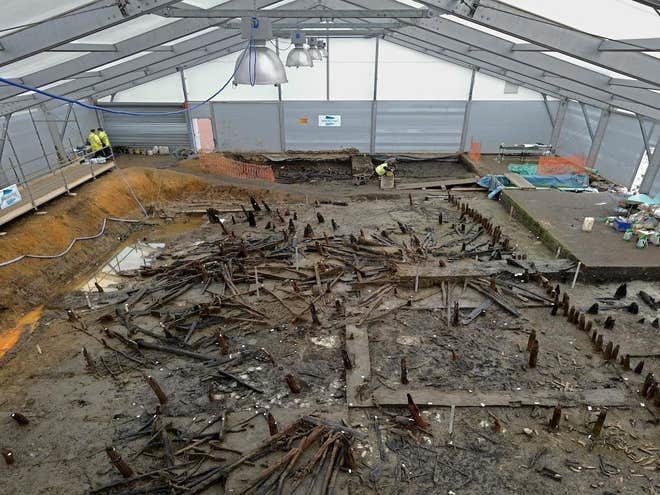
Prehistoric people living in a settlement perched on freshwater marshes in eastern England were infected by intestinal worms caught from foraging for food in lakes and waterways, according to researchers from the University of Cambridge.
The 900BC Bronze Age settlement at Must Farm - located near what is now the fenland city of Peterborough - was made of wooden houses built on stilts above the water. A wooden causeway connected islands on the marsh and inhabitants used dugout canoes to travel along the channels.
Three-thousand years ago, a catastrophic fire burnt the village down, but artefacts from the houses such as food, clothes and jewellery were preserved in the mud.
In this waterlogged sludge, scientists also found pieces of human faeces which contained ancient parasite eggs.
Dr Piers Mitchell from Cambridge's Department of Archaeology told The Independent the find has given them a fascinating insight into how common certain diseases were at the time. He said: "We can start to see that pretty much everyone had some kind of intestinal parasite.
"We have found the earliest evidence for fish tapeworm, Echinostoma worm, and giant kidney worm in Britain.
"These parasites are spread by eating raw aquatic animals such as fish, amphibians and molluscs. Living over slow-moving water may have protected the inhabitants from some parasites, but put them at risk of others if they ate fish or frogs."
Fish tapeworms grow up to 10cm in length and live coiled up in the intestines. Echinostoma worms are much smaller - up to just 1cm in length. They cause inflammation in the intestinal lining.
The giant kidney worm is a parasitic roundworm that in humans typically infects one kidney. They have been known to reach 1m in length and their presence normally causes severe kidney fibrosis.
Scientists also found pig whipworm and Capillaria worm which probably originated from the butchery and the consumption of the intestines from other animals, although it is unlikely they caused any harm.
The waste water around the site - sometimes referred to as "Britain's Pompeii" - would have been quite stagnant because of the reed beds, therefore allowing human waste to accumulate in the channels. This would have been a good breeding ground for parasites to infect local wildlife, which could have spread to the villagers if they ate raw or poorly cooked food, according to the study published in Parasitology.
Dr Mitchell said: "They were getting most of their food from the water so they've got a completely different set of parasites to people in Dorset in the Bronze Age where you get a different pattern of diseases.
"If you have a heavy load of lots of different parasites it can lead to malnutrition and it can contribute to your death. But the aim of these parasites is to keep you alive as long as possible so they keep spreading themselves.
"So parasites in your intestines and kidneys are not designed to kill you but just to make you ill for a number of years."
As writing was only introduced into Britain centuries later with the Romans, there is little record of how these people lived.
"This research enables us for the first time to clearly understand the infectious diseases experienced by prehistoric people living in the Fens," said first author Marissa Ledger, also from Cambridge's Department of Archaeology.
Researchers found that while some of the excrement was from humans, others were from dogs. "Both humans and dogs were infected by similar parasitic worms, which suggests the humans were sharing their food or leftovers with their dogs," said Dr Ledger.
The parasites found at Must Farm tally with trends seen at other Bronze Age and Neolithic sites.
"Our study fits with the broader pattern of a shrinking of the parasite ecosystem through time. Changes in diet, sanitation and human-animal relationships over millennia have affected rates of parasitic infection," said Dr Mitchell.
However, the fish tapeworm seen at Must Farm have seen a recent resurgence in modern humans because of increasing popularity of sushi, smoked salmon and ceviche.
"We now need to study other sites in prehistoric Britain where people lived different lifestyles, to help us understand how our ancestors' way of life affected their risk of developing infectious diseases," he said.
In 2016 excavations from the site revealed that inhabitants of the settlement had a taste for high-end fashion. Excavations unearthed the earliest examples of superfine textiles ever found in Britain.
University of Cambridge archaeologists unearthed more than 100 fragments of textile, unspun processed fibre and textile yarn at the site.
Some of the yarn is of superfine quality - with some threads being just 100 microns (1/10 of a millimetre) in diameter, while some of the fabrics themselves are so finely woven that they have 28 threads per centimetre, fine even by modern standards.
When the village was flourishing around 3000 years ago, textile manufacture seems to have been a key craft practised there.



Comment: These houses reflect a similar living arrangement to the Crannogs discovered in Scotland: Crannogs: Neolithic artificial islands in Scotland stump archeologists
It's curious that, while these people were seemingly ignorant - or unable to deal with - sanitation and parasites, they also had fabrics that were of the finest quality. The following article provides more details and clues on just what life was like at Must Farm: "Catastrophic" fire destroyed incredible British Bronze Age settlement a year after it was built
See also: